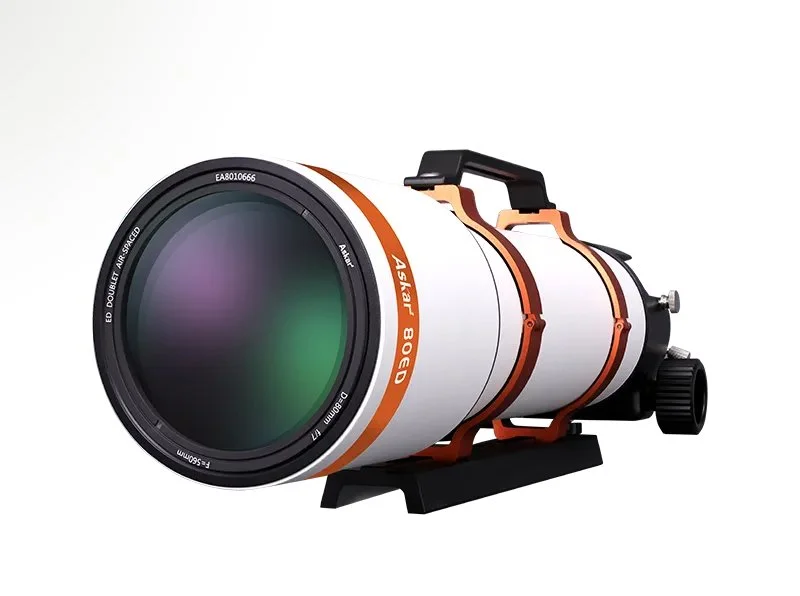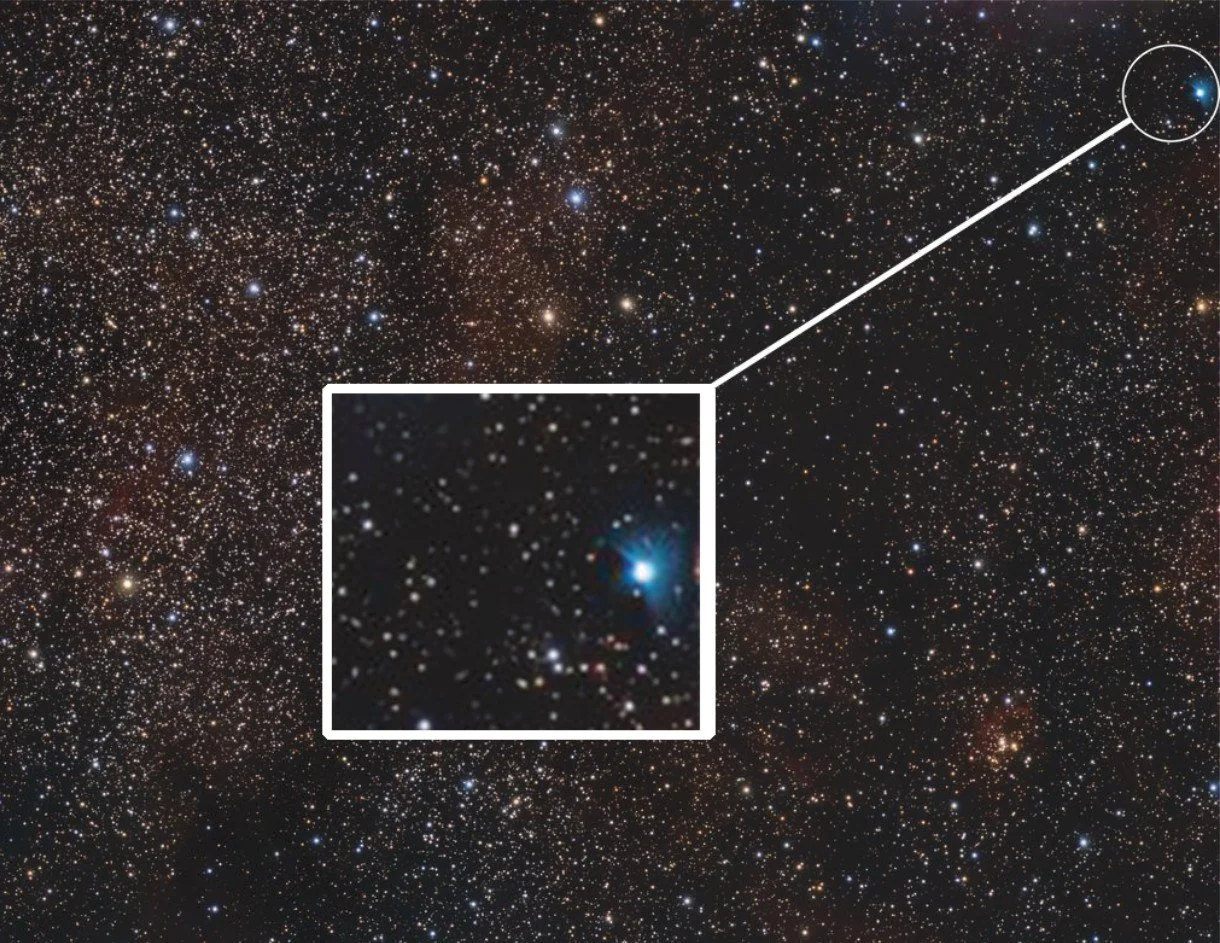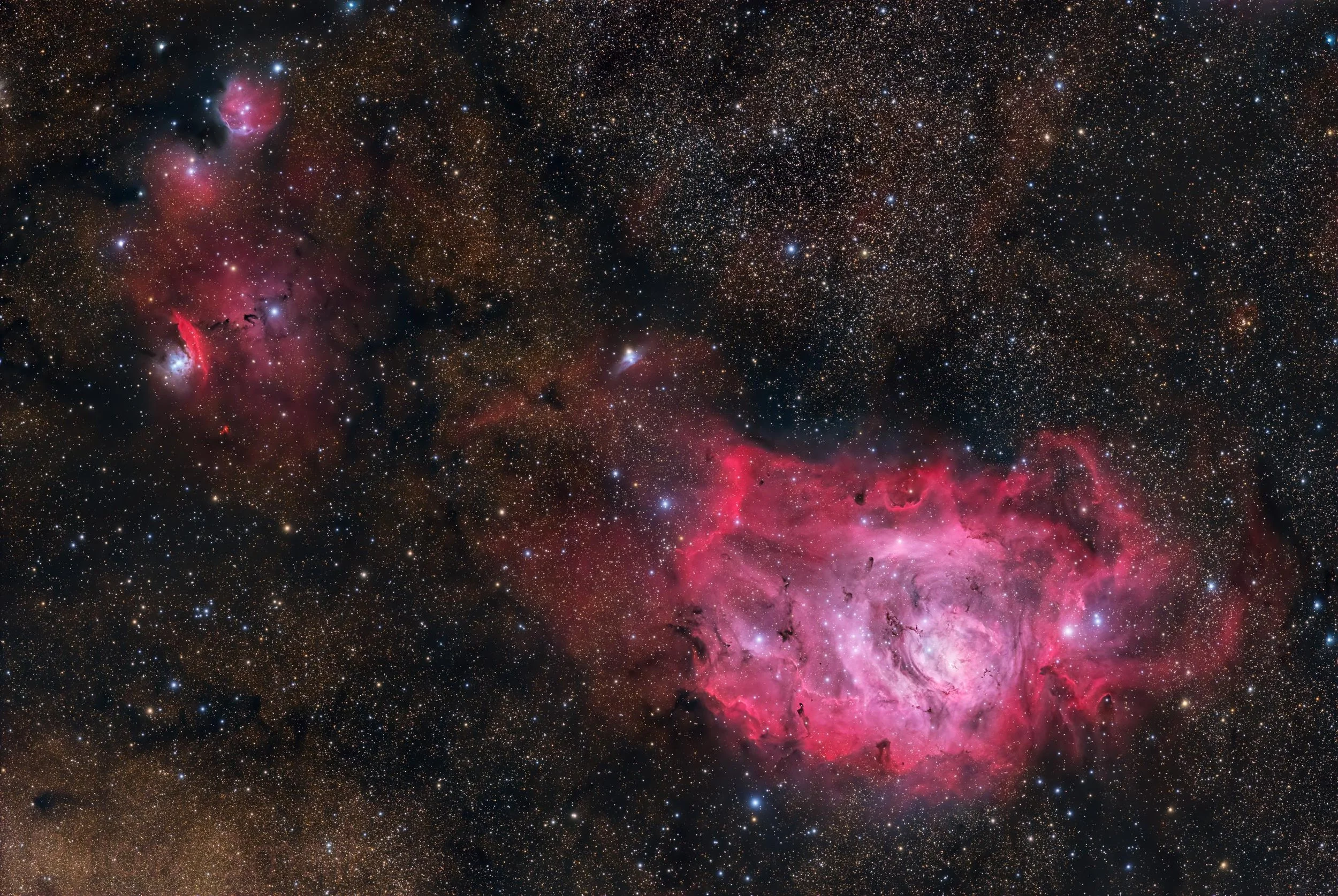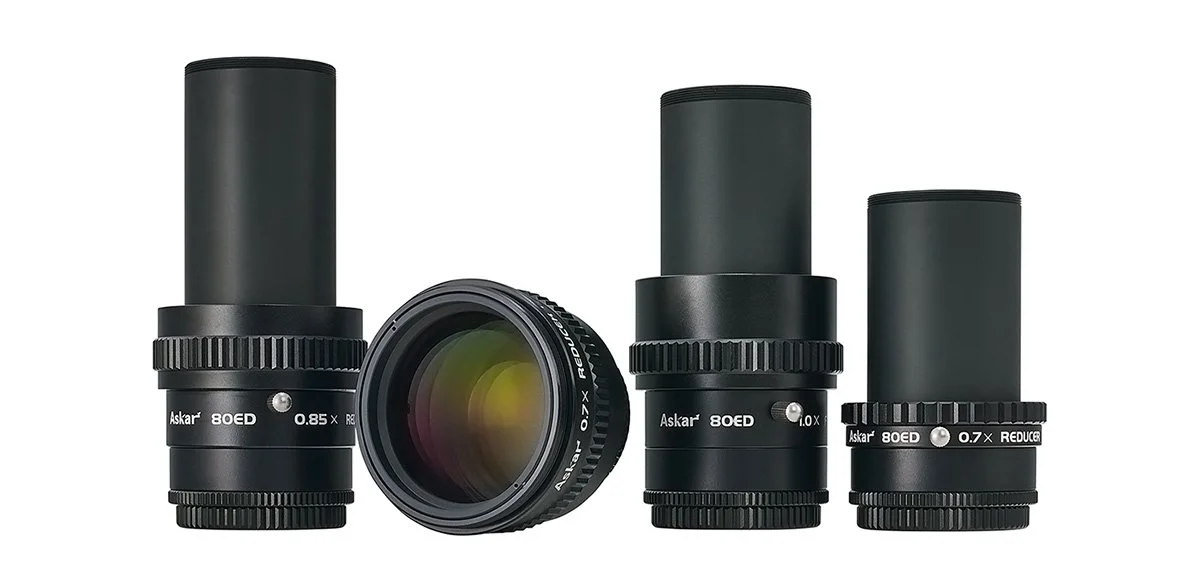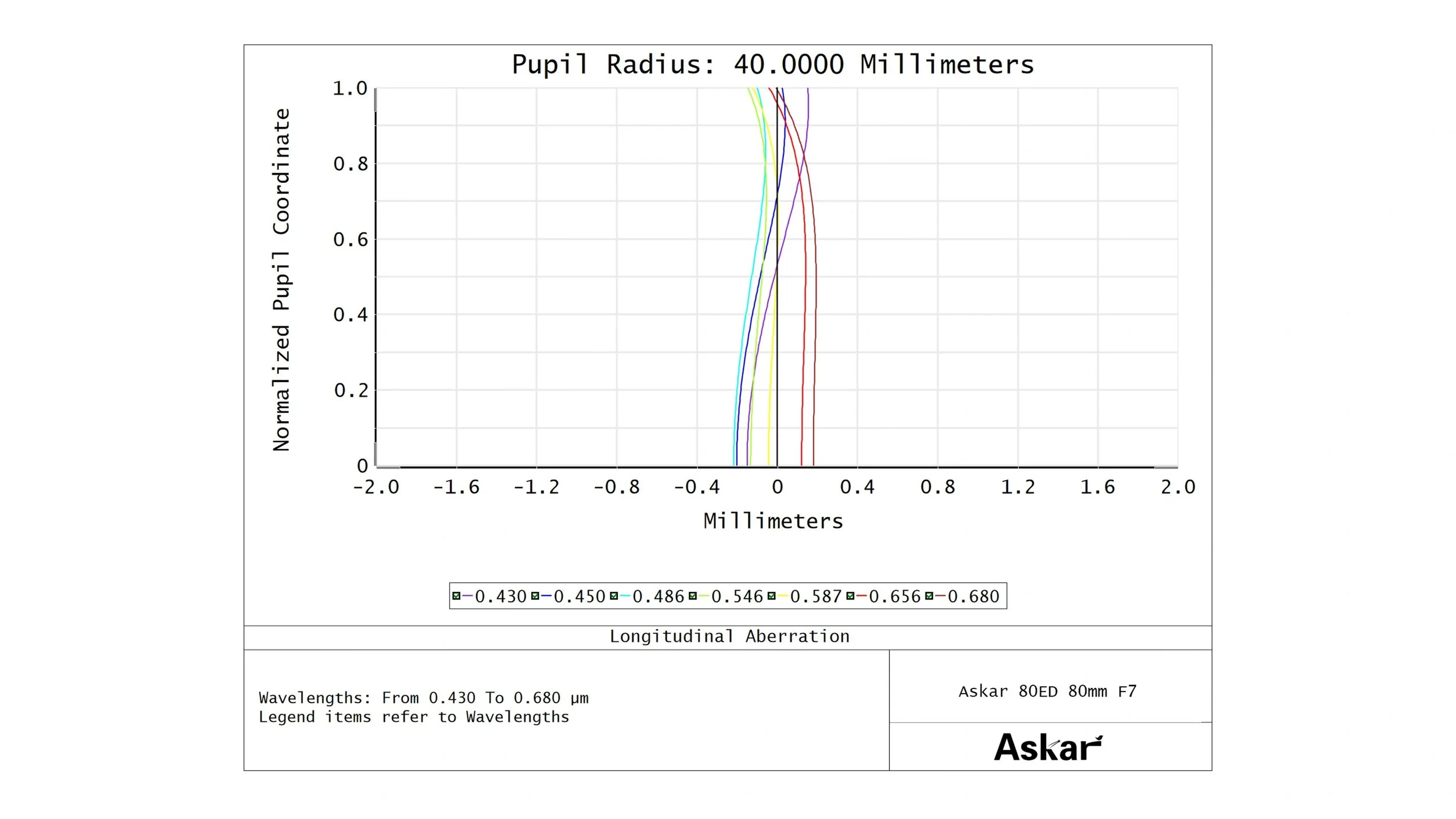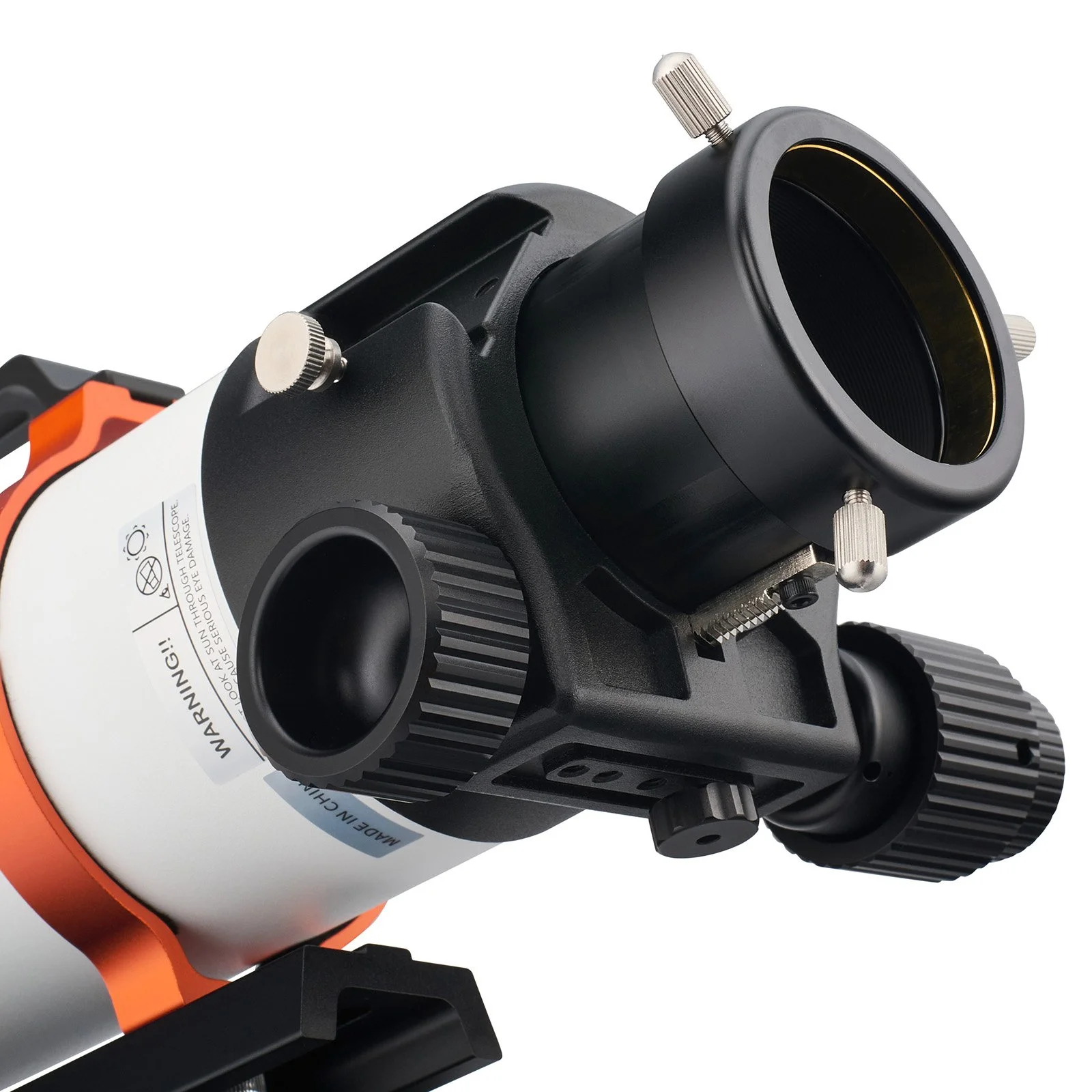Askar 80ED : Astonishingly Light and Budget-Friendly
Askar 80ED has a native 560mm focal length at f/7
With their latest model of refractor telescope, Askar 80ED, SharpStar have targeted a specific group of astrophotographers and astronomers which can place this product in a very attractive place: Beginners.
With a two-lens design (one ED, one standard), it reduces much of the chromatic error typical of simple doublets, while staying lighter and more affordable than full apochromats. Its 560mm focal length makes it a sweet spot for wide-field targets and paired with a dedicated flattener or reducers, it can remain useful as your imaging ambitions grow.
As SharpStar has demonstrated with their other telescopes, the 80ED is also designed to be modular and expandable: solid out of the box, but customisable via optional accessories (reducers, flattener) to expand its versatility.
💡 What is ED Glass?
ED (Extra-low Dispersion) glass is a special type of optical glass that reduces chromatic aberration and colour fringing around bright objects.
- How it works: ED glass bends light wavelengths more precisely, helping them converge on the same focal point.
- Why it matters: Stars and planets appear sharper, with more accurate colours and higher contrast.
- Beginner benefit: Cleaner, sharper views at a lower price point than high-end triplets.
In short: ED glass delivers cleaner, sharper images of stars, and deep-sky objects.
Why the 80mm Diameter Matters
Many of the major telescope manufacturers devote particular attention to their 80mm refractor telescopes — some even offer several models at this aperture. There’s a good reason for that: an 80mm refractor strikes a rare balance between capability and practicality.
It’s suitable for deep-sky astrophotography, yet remains lightweight and highly portable. It doesn’t demand an expensive or bulky tracking mount, and is often affordable enough for beginners while still appealing to experienced astrophotographers. With the addition of a focal reducer, an 80mm refractor can even transform into a wide-field imaging instrument with an attractive focal ratio — making it one of the most versatile telescopes for astrophotography.
Optical & Imaging Performance
While Askar 80ED performs well to render light, but with brighter stars near the edges, it can struggle, especially when using a bigger camera sensor.
Sharpness, Stars Quality and Colour Accuracy
The Askar 80ED delivers reasonably sharp stars across the field of view, if that field of view is not large. A micro four/third sensor is ideal for this telescope.
Edge/corner performance is good given its class, but not perfect: some star pinching or slight aberrations may appear whether using the dedicated field flattener or reducers, especially with cameras with larger sensors.
The inclusion of ED glass helps mitigate chromatic aberration far better than pure achromatic doublets. Overall the colour fidelity is pretty impressive for such an affordable telescope.
Lagoon Nebula by (小豆枕)
Imaging Accessories — how it scales
3 field correctors: 0.7× reducer, 0.85× reducer, and 1.0× flattener specifically for the 80ED.
SharpStar offers a 0.7× reducer, 0.85× reducer, and 1.0× flattener specifically for the 80ED, helping flatten the field.
With the 0.7× reducer, effective focal length becomes approximately 392mm at f/4.9, enabling wide fields imaging at a reasonably fast speed.
The 0.85× reducer yields approximately 476mm at f/5.9, expanding the adaptability of the Askat 80ED.
In summary: For smaller camera sensors, the 80ED can remain a strong imaging tool. But for full-frame cameras, you’ll notice limitations without having to crop your image.
Build Quality & Mechanics
The telescope’s construction is solid for its class: CNC-machined aluminium tube. The finish is clean, though not premium. This is where the price tag of $399 shows.
The focuser is a dual-speed rack & pinion with a 1:10 fine knob. It also support electronic focusers. The focuser itself, handles common imaging payloads (filter wheels, cameras). It doesn’t feel overly robust, so as long as you don’t impose heavy payload, it will function well.
Like other SharpStars telescopes, this one is also a very user-friendly telescope. Accessories like a Vixen style 20cm long dovetail bar, removable handle, detachable/reversable lens hood for better storage, 360° field rotator, and dual finder base slots are included. These features improve the user experience considerably.
Longitudinal Aberration: Askar 80Ed boasts a decent colour aberration correction thanks to its ED glass.
Things we love about Askar 80ED:
Extremely portable and travel-friendly. Thanks to its detachable dew-shield, it can even fit into your backpack.
If you are looking for other travel-friendly telescopes, read our review of the Askar SQA55.
Good optical performance for a budget doublet, making it a great choice for beginners.
Good range of dedicated field correctors (one field flattener and two field reducers).
A versatile focal length (560mm), it is perfect for many deep space targets. It can be turned into a wide-field telescope by using the two dedicated focal reducers that can be purchased separately.
The telescope comes with a checklist for quality control.
Incredible value for money, at just US$399 at the time of this review. (field correctors not included)
Things that could be improved:
Not suitable for cameras with larger sensors.
The optical system may struggle with big and bright stars. Star pinching can be noticeable if looked closely.
The built quality is not premium, but justifiable for the price tag of $399.
No carrying case included.
North American Nebula by Hang
Shopper’s Note: Pairings & Recommended Setup For Askar 80ED
The 360° field rotator and two finder base slots improve the user interface of the ED80.
Comparison to Alternatives
Compared to other achromats, Askar 80ED offers superior colour correction due to its ED element. Against premium triplet APOs, it offers lighter weight and lower cost, though there are trade-offs in built quality, optical performance, sharpness and colour fidelity. For many astronomers, Askar 80ED represents a “sweet middle ground”, decent performance, with portability and affordability in mind.
Without a doubt, the Askar 80ED telescope represents one of the best options for those who want to start their astrophotography journey.
In comparison to similar telescopes in the market, Askar 80ED performs slightly better than Svbony 70mm (also $399) in terms of sharpness and colour accuracy. But if you compare it to more expensive telescopes with similar diameter such as the TS-Optics 80 Triplet Apochromatic and the Sky-Watcher Esprit 80 ED PRO (almost $800), Askar 80ED falls short.
The ZWO FF80 provides a more streamlined experience by having far better optics, built-in field corrector (quadruplet) and a robust 3” focuser. But that comes at a price, more than 3 times more expensive than the Askar 80ED.
| Model | Native Focal Length | Focal Ratio | Objective Lens | Focuser | OTA Weight | Price (USD) |
|---|---|---|---|---|---|---|
| Askar 80 ED | 560 mm | f/7 | Doublet 2-element with ED glass | 2.5" R&P | 1.7 kg | $399 |
| Svbony SV503 | 420 mm | f/6 | Doublet 2-element with ED glass | 2" R&P | 3.24 kg | $399 |
| TS-Optics Photoline 80 APO | 480 mm | f/6 | Triplet Apochromatic with FPL53 element | 2.5" R&P Focuser | 3.14 kg | ~ $770 |
| Sky-Watcher Esprit 80 ED Pro | 400 mm | f/5 | Triplet Apochromatic with FPL53 element | 2.7” LPF | 3.97 kg | ~ $1,200 |
| ZWO FF80 APO | 600 mm | f/7.5 | Quadruplet APO with 2 ED glasses (flat-field) | 3" R&P Focuser | 3.9 kg | $1,299 | William Optics GT 81 IV | 478 mm | f/5.9 | Triplet Apochromatic with FPL53 element | 2.5" R&P Focuser | 3.9 kg | $1,568 |
Note: Specs are compiled from manufacturer product pages and major retailers. Prices are approximate retail ranges (USD) and will vary by region, retailer and whether the item is sold as OTA or as a kit.
About Sharpstar Optics:
Jiaxing Sharpstar Optical Instrument Co. Ltd. was founded in 2000 in Jiaxing, Zhejiang, China. They are specialised in research, development and production of astronomy instruments.
Sharpstar brand is divided into refractors and reflectors as well as mounts and tripods. And under the Askar brand there are SQA series, PHQ series, FRA series, APO series, FMA series, V series, F series as well as filters and accessories.
Astromaniac Magazine have reviewed other telescopes by SharpStar.
You can read our review of Askar 103APO as well as the Askar SQA55.

